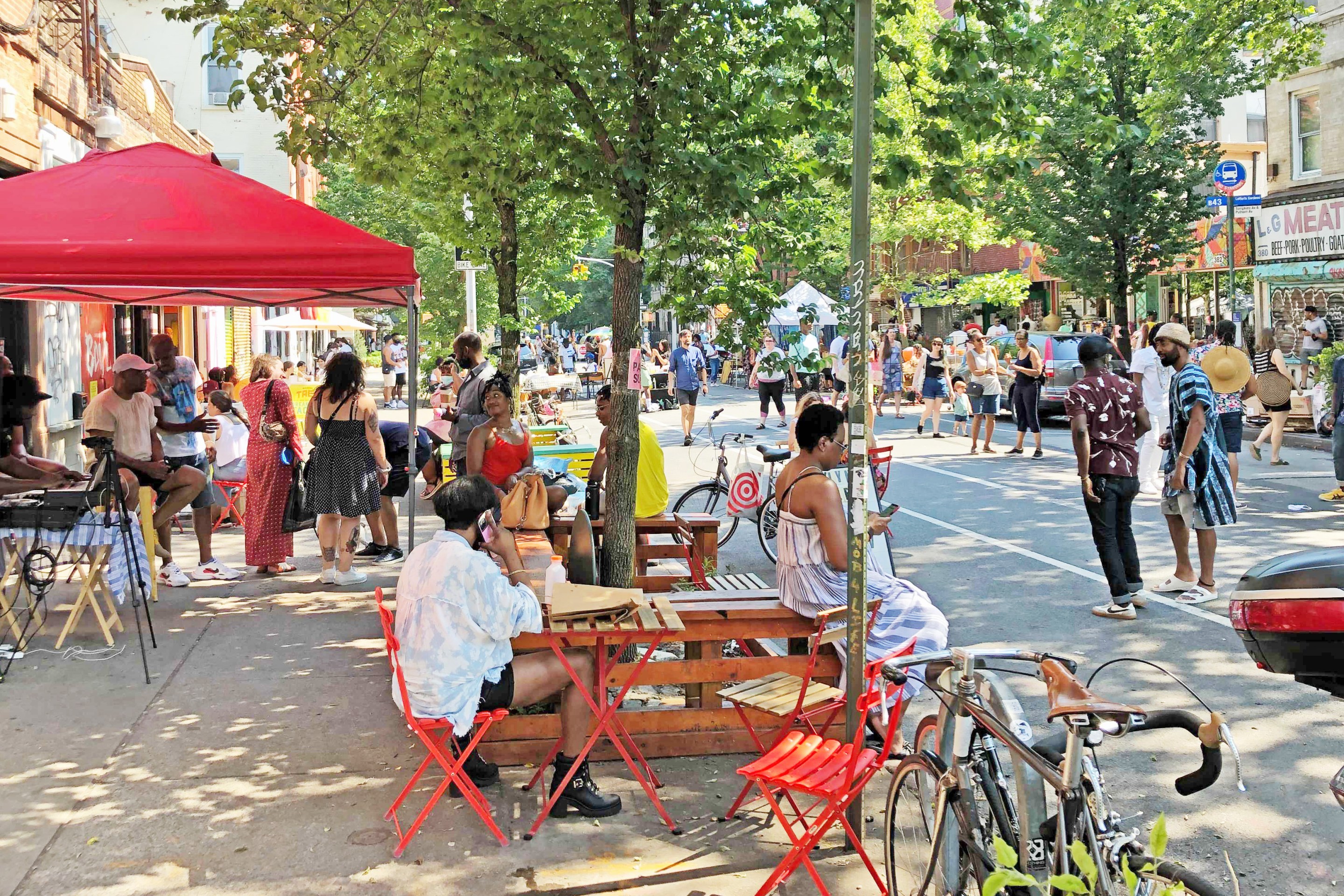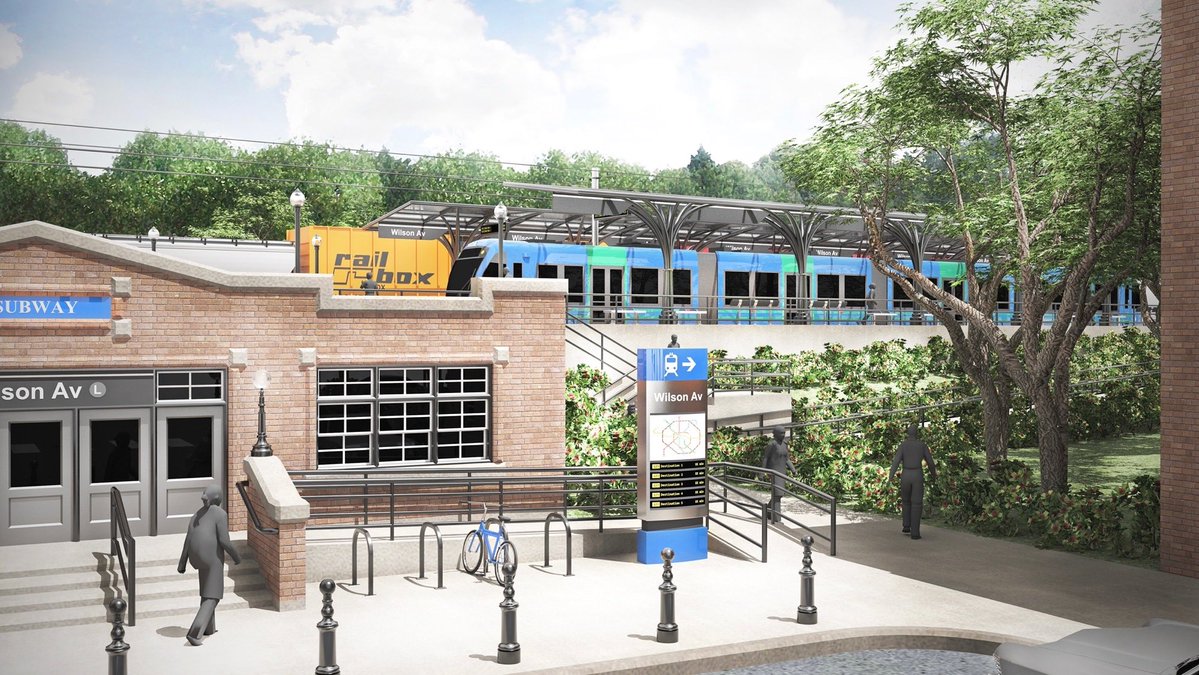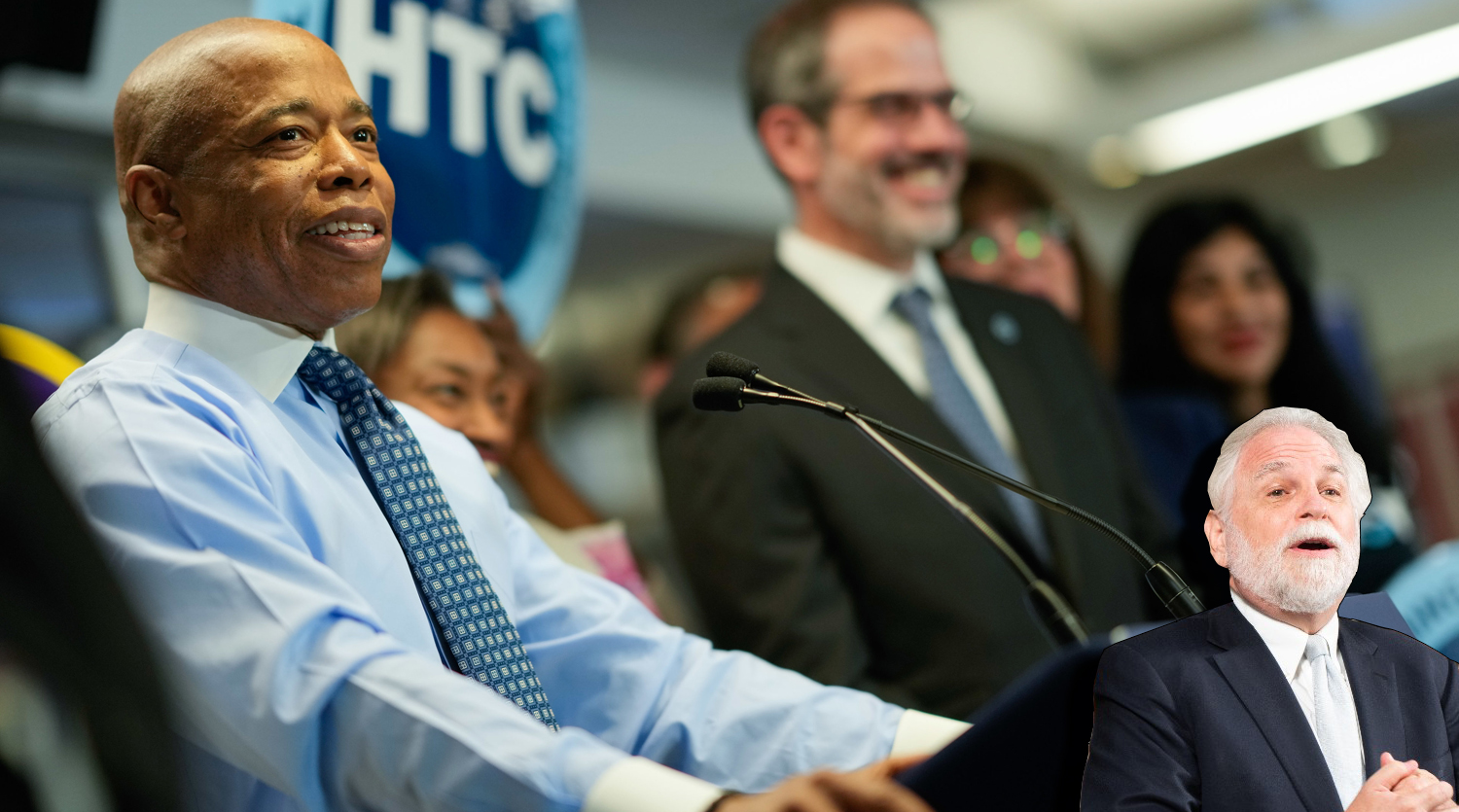Op-Ed: ‘Open Streets’ Isn’t Working for All of the People
12:00 PM EDT on July 7, 2020

A fitting image of the open streets program: Barricades busted by motorist. Photo: Sasha Aickin

If you've been following social media (and Streetsblog), you know that the city’s implementation of the "Open Streets" program has been rocky at best — car drivers are re-claiming roadways that are supposed to be off limits to them, neighborhoods have gotten City Hall to remove some open streets, barricades that protect kids and families have been set out inconsistently, and the amenity disproportionately benefits richer neighborhoods.
I needed to see it for myself.
So on Sunday, I visited 44 of the 79 Open Streets sites in Brooklyn on one long hot, sweaty, 40-mile, eight-hour ride from Williamsburg, through Bushwick, Brownsville, East New York, Crown Heights, Bedford-Stuyvesant, Prospect Heights, Park Slope, Boerum Hill, Brooklyn Heights, DUMBO, and back.
I live-tweeted all the way, posting my 280-character assessments that the program is flawed — a majority of streets are not even closed to car traffic! — and structurally racist in its implementation.
Here's a full report:
Brooklyn 'Open Streets' are not well chosen
First off, the Open Streets program doesn’t even make that much sense on paper. It may seem impressive at first blush to have 79 sites in Brooklyn, but there seems to be little to no strategy behind how the sites were chosen.
For example, 16 of the Open Streets I visited were just a single block long. It’s impossible for an Open Street to provide space for strolling and biking if you have to turn around every two minutes, and any Open Street that doesn’t achieve a critical mass of non-car users ambling down it is going to struggle.
It’s not a coincidence that the two NYC Open Streets most frequently cited as successful (Berry Street in Williamsburg and 34th Avenue in Jackson Heights) are more than a mile long — and chosen to maximize public engagement. By contrast, take a look at this Open Street I visited on Sackman Street at the border of Bed-Stuy and East New York: it’s only about 100 feet long. (And to add insult to injury, when I visited it, the NYPD was using it to store buses. The street is an insult to residents of the mostly Black community.)
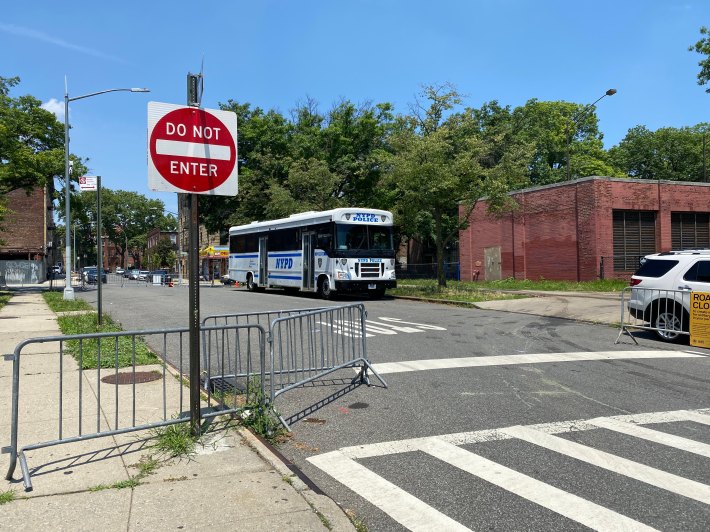
Further, many of the Open Streets in Brooklyn and around the city are adjacent to an existing park. This rather pointedly raises the question of what these Open Streets are even for, and I’m not sure the designers of the program know. The two justifications I hear most often for Open Streets are to provide open public space in areas that don’t have access to that space and to provide routes for active transportation. These reasons are doubly important in an era when distancing is in effect and when public transit may carry added risks. But park-adjacent Open Streets fulfill neither of these goals: they are directly next to existing usable public open space and are usually no more than two or three blocks long, providing no meaningful transportation benefit.
And where there are multiple sites in a neighborhood, they often are disconnected in weird and inexplicable ways. For example, look at these two Open Streets sites near McCarren Park (below):
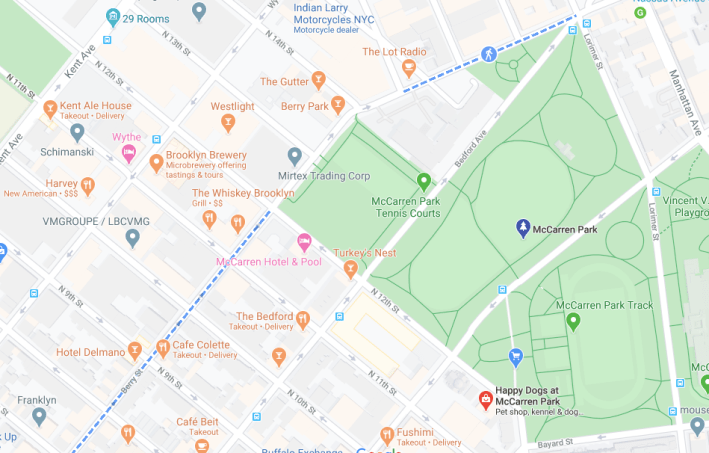
Why is there a three-block interruption between these two sites? Why not connect them, especially considering the blocks in question are fairly low traffic to begin with? I saw this pattern repeated all around Brooklyn, from Wyckoff Street in Boerum Hill to Stanley Avenue and Blake Avenue in East New York.
It’s hard to reverse engineer exactly how the siting plan for Open Streets went wrong, but from public statements, it seems that it probably came from a focus on numbers over a focus on communities and street users’ needs. The mayor pledged 100 miles of Open Streets in May, and he is now touting that New York has the most Open Street mileage of any city in the country. That seems to have led the project to prioritize raw mileage over a holistic view of how people and communities want to use their streets or any sense of what conditions it takes for an Open Street site to be successful.
Implementation in Brooklyn is abysmal
Worse than the siting has been the implementation. I am far from the first to notice that many Open Streets have been effectively cancelled by people moving barricades off the street and onto the sidewalk. In many cases, I found the barricades damaged, sidelined, or even demolished, presumably by drivers who thought they could just power through.
Over the course of my ride, I surveyed 112 blocks that were supposed to be closed to thru-traffic as part of Open Streets — but 57 percent of those blocks were not closed to traffic. Of the 44 sites I visited, only 20 existed at all. Think about that for a second: less than half of the Open Streets being touted by the mayor even exist in any form. That’s shameful.
I suspect that at least part of the problem here is design. The vast majority of the streets are blocked off with NYPD sawhorses, to which is attached a laminated piece of 11-by-17 paper that is not legible to drivers; the text telling motorists of the 5 mile-per-hour speed limit is literally one inch tall. In what other context do we create one-inch high speed limit signs for drivers? In what world would we expect that to be useful?
These barriers are also not standard traffic-control devices, and as such, drivers don't take them seriously. They are wooden and painted blue, as opposed to the more standard orange and white of street and construction barriers throughout the city. This probably invites drivers to think it’s acceptable to move them off the roadway. In addition, the fact that they have “Police Line” and “NYPD” emblazoned on them is decidedly not helpful, especially in neighborhoods where trust in police is at an all-time low.
A failure of implementation this complete cannot be placed solely on design, but on the city's follow through. On street after street with sidelined barricades, I kept asking myself: who is responsible for making sure these Open Streets are working? Is there anyone whose job it is to engage with the community about what’s working and what isn’t, to iterate on the implementation, and to physically replace the barricades in the streets when they are moved? Has there been literally any attempt to engage the communities around these sites? From what I saw on my ride around Brooklyn, my best guess is that the answer is an emphatic “no."
The Brooklyn program is structurally racist, at best
The starkest lesson: There is a fundamental a racial divide in the Brooklyn Open Streets implementation. Many other folks, including the Open Streets Coalition, have noted the stark disparity in the number of Open Streets sites in white and non-white neighborhoods. I noticed this as well when I was planning my ride; the sites were thick in Cobble Hill and Brooklyn Heights and almost non-existent in the heart of Bed-Stuy.
Once I got pedaling, though, the disparities got worse. As I rode from site to site in Bushwick, Brownsville, East New York, and Crown Heights, nearly every single "Open Street” was only open to cars. I started to despair that I would ever see an Open Street again.
Y’all, I haven’t seen an actual open street in *hours*.
— Sasha Aickin (@xander76) July 5, 2020
As soon as I made my way into the largely White neighborhoods of Prospect Heights, Park Slope, Boerum Hill, and Brooklyn Heights, though, Open Streets were present once again. When I got home and matched my data up with Energy Justice Network’s excellent block-by-block racial map of New York City, the results were searing. In Open Streets projects I visited, 70 percent of the plurality White blocks were closed to cars, compared to just 12 percent of the plurality non-White blocks.
Twelve percent.
I want to say this in the clearest terms: Open Streets in Brooklyn are effectively only open if White people live on them, and that’s unacceptable.
I’ve spent a good deal of my career looking at and analyzing geographic data, and the connection between racial makeup of a block and implementation status of an Open Street was one of the strongest correlations I’ve ever seen. In one example, there were two projects separated by just two blocks. One of the Open Streets existed and had healthy engagement, and the other didn’t. The line where the neighborhood went from plurality Black to plurality White is in that two-block gap between the two projects. It’s hard for me to see outcomes like this and not believe that there’s structural racism at work.
I don’t know what is causing this disparity in implementation, but I observed that working Open Streets had one or more people on the block tending to them: repairing and replacing the barricades, creating new and bigger signage, even extending the Open Street to blocks not sanctioned by the city. In other words, someone (or several someones) from the block was stepping in because the city hadn’t bothered to implement the program.
Make no mistake, though: this is structural racism at work. We know that folks in majority White neighborhoods on average have more time and resources than folks in other neighborhoods, and we know that more of them proportionally are working from home these days. If the city creates a program that depends on the residents being home and having the time and resources to implement it by themselves, then that program is only going to work in richer, whiter neighborhoods.
That’s not acceptable, and it builds on and reinforces historical injustices. It’s racist, plain and simple. This isn’t hard.
In any event, it definitely suggests that DOT Commissioner Polly Trottenberg is not living up to her promise, made to Streetsblog on the very first day of the Open Streets initiative, that "city staff" would "step in" to "make sure [open streets will happen" in "neighborhoods where maybe there isn’t a local partner."
I should also note the current debate about what truly constitutes a “safe street” for Black residents, and many Black planners have been rightly critical of White urbanists’ dismissals of their concerns about Open Streets as a solution. I take those points and am actively trying to integrate them into my urbanism. It’s absolutely fair to question and critique the relative value of Open Streets to Black communities. What I’m fairly certain about, though, is that if a city chooses to implement an Open Streets program, it should actually go through with implementing it.
New York City did not make a conscious choice to not implement Open Streets in non-white neighborhoods in response to what those communities said they wanted; New York City just chose to not implement their Open Streets at all.
Conclusion
You can only learn so much in one day, but the Open Streets I saw in Brooklyn were a far cry from my ideal of freedom, space, and community building. And it doesn’t have to be that way.
Implementing urban policy is hard, and it’s extra hard in a time of shrinking budgets and health crises. But that can't be an excuse for this shoddy program, which seems to consist of little more than a press conference, a website, and some police barricades unceremoniously plopped on a street with no explanation or further community engagement.
And when you’re working on an urban foundation that consists of decades of malignant, racist policy and outcomes, carelessness like that will inevitably just make the situation even worse. I truly believe that Open Streets still have the potential to be wonderful, but New York City doesn’t seem to be willing to put in the work to make them so.
City Hall responds
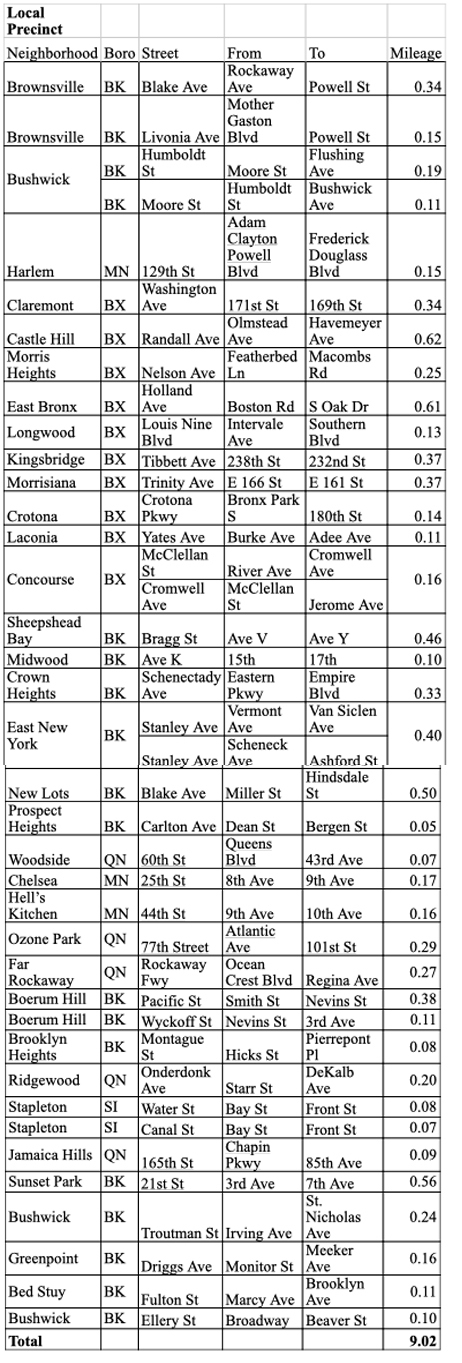
Editor's note: After Aickin submitted this story for publication, Streetsblog reached out to City Hall for a response.
Mayoral spokesman Mitch Schwartz said that the de Blasio administration has made "a meaningful commitment to equity." He criticized Aickin's one-borough analysis because it doesn't take into account the fact that "this is a citywide initiative not a Brooklyn-specific initiative." (We reminded Schwartz that our "Eyes on the Street" column is never scientific, but reflects what we saw on the street at a given time at a given place. We also reminded him that from the very first day, Streetsblog has been raising issues about whether the program would be implemented in an equitable manner.)
He provided the chart of the open streets that were added in June (right) that brought the citywide total to about 57 miles of recreation streets.
He claimed that this additional nine miles broadened City Hall's commitment to equity. That claim is very much in doubt and will be fully explored by Streetsblog in an upcoming story.
In addition, Aickin offered a rebuttal to Schwartz:
"I actually visited 15 of the 18 Brooklyn segments in that chart. Ten of those 15 segments didn't exist (Blake, Livonia, Humboldt, Moore, Schenectady, Stanley, Stanley, Blake, Wyckoff, and Ellery). In response to the 'one borough' criticism, I'd note that I took at pains in the article to say that I was evaluating Open Streets in Brooklyn, not the program as a whole. And I think that it's more than fair to want Open Streets to work in Brooklyn, and, indeed, in all five boroughs."
Sasha Aickin lives in Brooklyn and is the former CTO at Redfin and a board member at YIMBY Action. Follow him on Twitter at @xander76.
Read More:
Stay in touch
Sign up for our free newsletter
More from Streetsblog New York City
Wednesday’s Headlines: Four for Fifth Edition
The good news? There's a new operator for the Fifth Avenue open street. The bad news? It's four blocks, down from 15 last year. Plus other news.
MTA Plan to Run Brooklyn-Queens Train on City Streets a ‘Grave’ Mistake: Advocates
A 515-foot tunnel beneath All Faiths Cemetery would slightly increase the cost of the project in exchange for "enormous" service benefits, a new report argues.
Full Court Press by Mayor for Congestion Pricing Foe Randy Mastro
Pay no attention to that lawyer behind the curtain fighting for New Jersey, the mayor's team said on Tuesday, channeling the Wizard of Oz.
Tuesday’s Headlines: Valley of Political Death Edition
Did you see the new poll showing congestion pricing is really unpopular? Ignore it! Good times are coming. Plus other news in today's headlines.
Open Streets Groups Warn of Extra Red Tape to Run Events
Two weeks notice for hopscotch or a yoga class?
